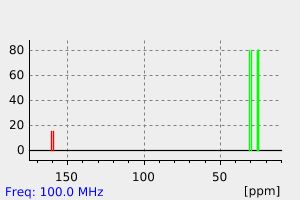4,5,6,7,8,9-hexahydro-cycloocta[1,2,3]selenadiazole | 35676-31-4
中文名称
——
中文别名
——
英文名称
4,5,6,7,8,9-hexahydro-cycloocta[1,2,3]selenadiazole
英文别名
4,5,6,7,8,9-Hexahydrocycloocta-1,2,3-selenadiazol;Cycloocteno-1,2,3-selenadiazol;cycloocteno-1,2,3-selenadiazole;4,5,6,7,8,9-Hexahydrocycloocta[d][1,2,3]selenadiazole;4,5,6,7,8,9-hexahydrocycloocta[d]selenadiazole
CAS
35676-31-4
化学式
C8H12N2Se
mdl
——
分子量
215.157
InChiKey
TUSGQZDPAZUMGA-UHFFFAOYSA-N
BEILSTEIN
——
EINECS
——
-
物化性质
-
计算性质
-
ADMET
-
安全信息
-
SDS
-
制备方法与用途
-
上下游信息
-
文献信息
-
表征谱图
-
同类化合物
-
相关功能分类
-
相关结构分类
物化性质
-
沸点:298.7±43.0 °C(Predicted)
计算性质
-
辛醇/水分配系数(LogP):1.19
-
重原子数:11
-
可旋转键数:0
-
环数:2.0
-
sp3杂化的碳原子比例:0.75
-
拓扑面积:25.8
-
氢给体数:0
-
氢受体数:2
反应信息
-
作为反应物:描述:参考文献:名称:Buehl,H. et al., Synthesis, 1978, p. 536 - 537摘要:DOI:
-
作为产物:描述:cyclooctanone semicarbazone 在 硒脲酸 作用下, 以 neat (no solvent) 为溶剂, 生成 4,5,6,7,8,9-hexahydro-cycloocta[1,2,3]selenadiazole参考文献:名称:微波合成双(环烯基)-1,4-二硒精:CdSe QDs的硒的新来源†摘要:本文介绍了通过微波辐射(MW)方法由相应的环烯基1,2,3-硒代二唑形成一系列的双(环烯基)-1,4-二硒精。1,2,3-硒代二唑的双自由基二聚反应是通过一种新的合成策略在无溶剂条件下使用100瓦特微波辐照约20分钟进行的。当前的合成为制备各种1,4-二硒精提供了可行的方法。如此制备的烷基硒化物通过各种光谱学工具表征。紫外线可见,FTIR,1 H,13 C,DEPT和77Se NMR光谱,ESI-MS和TGA分析。另外,双(环庚烯)-1,4-二硒精已被有效地用作合成CdSe量子点(QDs)的新型硒前体。这种富含硒的前体也可能用于制备其他金属硒化物。DOI:10.1039/c7nj00793k
文献信息
-
Study and application of noncatalyzed photoinduced conjugation of azides and cycloocta-1,2,3-selenadiazoles作者:P. Jedináková、P. Šebej、T. Slanina、P. Klán、J. HlaváčDOI:10.1039/c6cc01789d日期:——
The non-catalyzed cycloaddition of eight structurally different azides with cyclooctyne generated
in situ by the photolysis of cycloocta-1,2,3-selenadiazole gives 1,2,3-triazole derivatives as the main products. -
Synthesis and Properties of Palladium Diselenolenes: X-ray Crystal Structures of [Pd{SeC(R<sup>1</sup>)C(R<sup>2</sup>)Se}(PBu<sub>3</sub>)<sub>2</sub>] [R<sup>1</sup>, R<sup>2</sup> = (CH<sub>2</sub>)<i><sub>n</sub></i>, <i>n</i> = 4, 5, 6]作者:Susan Ford、Christopher P. Morley、Massimo Di VairaDOI:10.1021/ic040069y日期:2004.11.1The reaction between [Pd(2)(dba)(3)] (dba = dibenzylideneacetone), tributylphosphine, and a bis(cycloalkeno)-1,4-diselenin leads to either a mononuclear diselenolene [Pd[SeC(R(1))=C(R(2))Se](PBu(3))(2)] or a dinuclear diselenolene [Pd(2)[SeC(R(1))=C(R(2))Se](2)(PBu(3))(2)] [R(1), R(2) = (CH(2))(n), n = 4, 5, 6] depending on the stoichiometry employed. Treatment of the dinuclear diselenolenes with 1[Pd(2)(dba)(3)](dba =二苄叉基丙酮),三丁基膦和双(环烯基)-1,4-二硒烯之间的反应会导致单核二硒烯[Pd [SeC(R(1)) )= C(R(2))Se](PBu(3))(2)]或双核二硒烯[Pd(2)[SeC(R(1))= C(R(2))Se](2 )(PBu(3))(2)] [R(1),R(2)=(CH(2))(n),n = 4,5,6],取决于所用的化学计量。用1,2-双(二苯基膦基)乙烷(dppe)处理双核二硒烯为单核物质[Pd [SeC(R(1))= C(R(2))Se](dppe)提供了高产途径)]。所有新化合物均已通过标准光谱学和分析技术进行了表征,尤其是通过多核NMR光谱学进行了表征;每个单核三丁基膦配合物的结构已经通过X射线晶体学测定。
-
The reaction of 1,2,3-selenadiazole with olefins作者:Yutaka Nishiyama*、Yasunobu Hada、Kuniko Iwase、Noboru Sonoda*DOI:10.1016/s0022-328x(00)00484-8日期:2000.10treated with an excess amount of olefins at 130°C, the addition of a vinyl radical, which was generated in situ by the denitrogenation of 1,2,3-selenadiazoles, to a carbon–carbon double bond followed by intramolecular cyclization proceeded efficiently giving the corresponding dihydroselenophenenes in moderate to good yields along with the formation of the corresponding 1,4-diselenins and selenophenes
-
Dinuclear diselenolenes derived from cycloalkeno-1,2,3-selenadiazoles and tetrakis(triphenylphosphine)palladium作者:Susan Ford、Pawan K. Khanna、Christopher P. Morley、Massimo Di VairaDOI:10.1039/a807666i日期:——Reaction of [Pd(PPh3)4] with cycloalkeno-1,2,3-selenadiazoles or bis(cycloalkeno)-1,4-diselenines in toluene under reflux led in good yield to the dinuclear diselenolenes [Pd2SeC(R1)C(R2)Se}2(PPh3)2] [R1,R2 = (CH2)n; n = 4, 5, 6] which have been characterised by microanalysis, multinuclear NMR, IR, and mass spectroscopy; the molecular structure of the compound with n = 6 has been determined by X-ray cystallography.
-
Tributylstannyl Radical-Catalyzed Reaction of 1,2,3-Selenadiazoles with Olefins or Dienes作者:Yutaka Nishiyama、Yasunobu Hada、Masahiro Anjiki、Kazuya Miyake、Sakiko Hanita、Noboru SonodaDOI:10.1021/jo010893t日期:2002.3.1It was found that the reaction of 1,2,3-selenadiazoles derived from cyclic ketones with olefins or dienes was markedly promoted by a catalytic amount of tributylstannyl radical, which was generated in situ from tributylstannyl hydride or allyltributylstannane and AIBN, to give the corresponding dihydroselenophenes in moderate to good yields. In contrast, when 1,2,3-selenadiazoles prepared from linear
表征谱图
-
氢谱1HNMR
-
质谱MS
-
碳谱13CNMR
-
红外IR
-
拉曼Raman
-
峰位数据
-
峰位匹配
-
表征信息
同类化合物
(SP-4-1)-二氯双(1-苯基-1H-咪唑-κN3)-钯
(5aS,6R,9S,9aR)-5a,6,7,8,9,9a-六氢-6,11,11-三甲基-2-(2,3,4,5,6-五氟苯基)-6,9-甲基-4H-[1,2,4]三唑[3,4-c][1,4]苯并恶嗪四氟硼酸酯
(5-氨基-1,3,4-噻二唑-2-基)甲醇
齐墩果-2,12-二烯[2,3-d]异恶唑-28-酸
黄曲霉毒素H1
高效液相卡套柱
非昔硝唑
非布索坦杂质Z19
非布索坦杂质T
非布索坦杂质K
非布索坦杂质E
非布索坦杂质D
非布索坦杂质67
非布索坦杂质65
非布索坦杂质64
非布索坦杂质61
非布索坦代谢物67M-4
非布索坦代谢物67M-2
非布索坦代谢物 67M-1
非布索坦-D9
非布索坦
非唑拉明
雷非那酮-d7
雷西那德杂质2
雷西纳德杂质L
雷西纳德杂质H
雷西纳德杂质B
雷西纳德
雷西奈德杂质
阿西司特
阿莫奈韦
阿考替胺杂质9
阿米苯唑
阿米特罗13C2,15N2
阿瑞匹坦杂质
阿格列扎
阿扎司特
阿尔吡登
阿塔鲁伦中间体
阿培利司N-1
阿哌沙班杂质26
阿哌沙班杂质15
阿可替尼
阿作莫兰
阿佐塞米
镁(2+)(Z)-4'-羟基-3'-甲氧基肉桂酸酯
锌1,2-二甲基咪唑二氯化物
锌(II)(苯甲醇)(四苯基卟啉)
锌(II)(正丁醇)(四苯基卟啉)
锌(II)(异丁醇)(四苯基卟啉)







